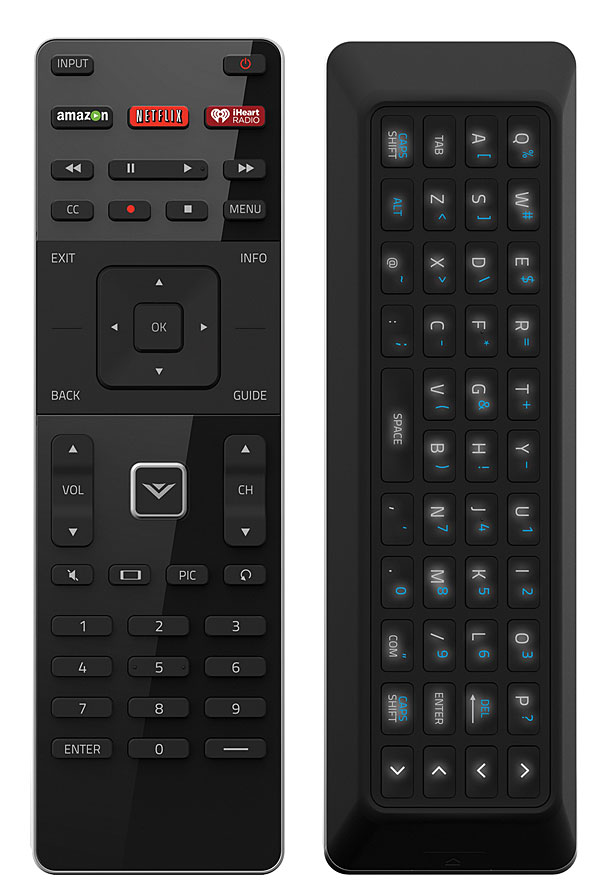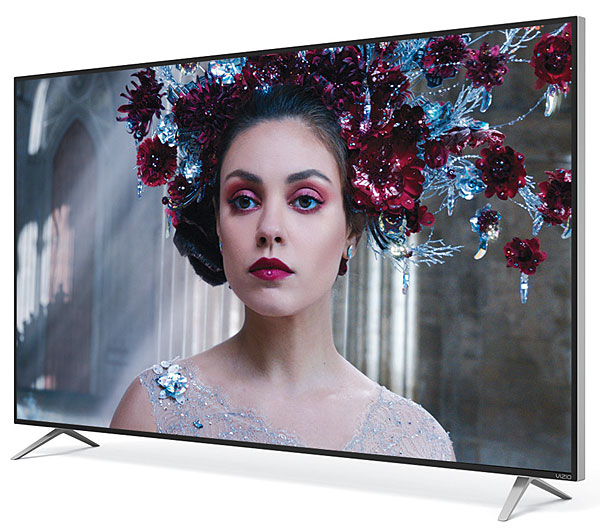Can you tell us the software version of your review set?
Vizio M65-C1 LCD Ultra HDTV Review Page 2
Off-axis performance was typical of most LCD displays. As I moved much beyond 20 to 25 degrees off center, the image became progressively more faded and desaturated.
The gamma curves weren’t particularly uniform; the most significant error in all settings was a consistently high gamma above the 60-percent brightness level (see the Test Bench). I often felt the need to change the gamma setting, depending on the source material. Most of the time, 2.1 or 2.2 worked best, but there were times when 2.0 or even 2.4 looked better.
Another problem turned up first in chapter 7 of The Lion King. As Mufasa lectures Simba on taking risks, his head moves against a twilight sky. This caused brief but severe brightness pumping. In the TV mini-series Titanic: Blood and Steel (viewed on Blu-ray), I noticed this again, in two scenes (one of them on disc three, chapter 11, at 7:45). With a single lamp in the background, obvious brightness pumping occurred when a character in the foreground intermittently blocked the lamp. The problem ceased when the Active LED Zones were turned off. My guess is that this is somehow related to the set’s relatively limited number of local dimming zones, or to the programming that controls the operation of those zones. But on most material, this artifact was rare, fleeting, and easy to ignore. I watched at least eight hours of the Titanic mini-series, which, being a period piece, is full of scenes with similarly difficult lighting. Only on those two occasions did I distinctly see the local dimming act up in this way, for a total time of roughly five seconds. Distracting, yes, but not enough to tempt me to turn the local dimming off.

Even while the Vizio had some nagging technical issues, normal program material told a different, far more positive story. Although the TV didn’t drop to total black on fade-outs in a fully darkened room (as pricier local dimmers often can do), it came very close—on a par with some of the last, best plasmas of the recent past. Among the black-level challenges I threw at the M65-C1 were episodes from the recent season of Game of Thrones (on cable) and from the 2009–2011 series Stargate Universe (on both Blu-ray and DVD). The Vizio had no trouble reproducing the latter’s generally gloomy setting, 90 percent of which takes place in the dark corridors and darker corners of an ancient starship. The TV also excelled in star fields from this and other material, as well as in the inky black bars it produced on widescreen films.
Nor did the Vizio’s resolution, including its upconversion to 4K, give me any reason to complain. Its color was also good, except for greens that were just a little too oversaturated—and couldn’t be reined in, even before I gave up on the CMS. And its screen uniformity, while not plasma perfect, was comparable to that of the best LCD sets I’ve tested.
4K Performance
On a 4K horizontal frequency sweep pattern, the Vizio emphasized discrete frequencies at the extreme top end—even with Sharpness set to zero. But with Sharpness at 20 (my preferred setting with normal source material), this appeared to have little or no effect on a more conventional 4K sharpness pattern or the real-
world 4K sources available to us.
However, such Ultra HD program material is still in very short supply. For my testing, it was limited to a few short subjects and the movie Chappie, all on Sony’s 4K server.
For this test, I moved the Vizio a little closer to my viewing position, though still about 9 feet away. While conventional 4K wisdom suggests that it should be even closer—perhaps as close as 5 to 6 feet for a 65-inch set—this is likely to be uncomfortably close for many viewers, even without considering the narrow optimum seating width for an LCD—an area that shrinks as you move closer to the set. In addition, the sound from speakers with multiple drivers may not coalesce properly to perform at its best at short range. The main exceptions will be speakers with coincident drivers (such as some designs from KEF, Tannoy, and Pioneer), or small two-way bookshelf systems where the woofer and tweeter are mounted very close together.

For some undetermined reason, the Sony server didn’t provide sound with the Vizio, though it did with the Samsung UN65JS9500FXZA. On the video side, the short subjects from the server were mostly unimpressive and in some ways looked worse than similar (though not identical) 1080p material on Blu-ray. Chappie looked far better, so I set up a comparison with two identically calibrated inputs, one playing the Blu-ray of the film, the other the 4K file. The upscaled 1080p source appeared a shade less smoothly fluid than the true 4K source. This was extremely subtle, however, and neither version looked clearly more detailed than the other. While this confirms the Vizio’s good 4K upconversion, it also reinforces my previous 4K experiences. That is, unless you have a very big screen (something like 80 inches or larger) or are willing to sit closer than most viewers prefer, the most dramatic benefits of Ultra HD will likely come from sources with upgraded color and higher dynamic range—neither of which are yet widely available (and neither of which most current 4K sets can make use of, including the Vizio). That doesn’t mean, of course, that a 4K set with good upconversion can’t produce an impressive picture from both true 4K material and upconverted 1080p. The Vizio can—and does.
Comparisons
With the recently reviewed high-end Samsung JS9500 TV still on hand, a comparison with the M65-C1 proved irresistible, in part due to their wide price differential: $4,500 street price for the Samsung as of late July versus $1,500 for the Vizio. Since I currently lack a one-in/two-out 4K splitter, however, all comparisons here were performed with 1080p Blu-ray material using the two outputs on
my Oppo BDP-105D player and upconverted by each set (not by
the Oppo).
Comparing two sets side-by-side isn’t as simple as it might seem. Even with both sets calibrated, such a comparison often requires slight changes to one or the other in its technically optimum Brightness, Contrast, Backlighting, and Gamma settings to get the two TVs as near to each other as possible. But when carefully tweaked, the Vizio and the Samsung could look remarkably similar, despite their considerable price difference. The Samsung’s greens were more natural, though the differences weren’t apparent on all material and were subtle when they were noticeable. Ditto with fleshtones.
On some material, the Vizio’s blacks on dark scenes actually pulled ahead, but in general (including fades to full-screen black) the Samsung won the black-level race by a nose. It also had sharper resolution, but again the differences weren’t always easy to spot. The Samsung’s local dimming, however, never misbehaved.
The most obvious differences between the two sets came from their gamma curves. Neither one followed a gamma curve precisely, but the Vizio deviated the most. Because it had a higher than optimum gamma at the top end (a higher gamma produces a darker result), its images sometimes appeared more saturated than the Samsung’s. This wasn’t always troubling, by any means. On some scenes, it actually enhanced the experience. But it wasn’t accurate, and as noted earlier, I often fiddled with the gamma setting on the Vizio to get the best subjective result, whereas I rarely felt any need to do so on the Samsung. (As noted in my Samsung review, however, I sometimes wished for one more downward step in its gamma options.)
The Samsung also offers readiness for advanced color and high dynamic range, plus state-of-the-art 3D—but all at a price.
Conclusions
The Vizio deviated from ideal technical performance in ways that may bother the fussy videophile.
And like most other current Ultra
HD sets, it lacks the capability to respond to the advanced color and high dynamic range we expect to see (eventually) from UHD program sources.
When properly set up, however, the Vizio can produce a visually compelling picture. I watched it for dozens of hours without itching to return to one of the two high-end sets I had on hand: the backlit Samsung (LCD) and the Panasonic TC-65ZT60 (plasma). Those are better sets in many ways, to be sure. But in the qualities that matter most to the average buyer—a big picture and an impressive viewing experience—the Vizio M65-C1 delivers at a less wallet-flattening sacrifice than most of its competition.
- Log in or register to post comments


For all those who are planning to upgrade their TV in the near future, I want to give some recommendations. I recently bought a new TV myself and was pleasantly surprised by the picture quality - 4K and OLED make the picture simply stunning. Smart features make it easy to stream content and use various applications. Plus, shark customer support is always in touch and ready to answer any questions.

Quality and reliability is very important to me when I choose a gaming site in Australia, and that's why I chose this gaming site - Heaps of Wins , because this site is perfect for playing online slot machines in Australia! I advise you to try to play here, because you will definitely like this site and you can play here easily and easily!

¡Hola, apostadores! Siempre me han gustado los tragamonedas, así que estuve buscando nuevas opciones y encontré una lista completa en https://wsgargentina2022.com/tragamonedas/. Probé varios juegos y me encantaron las temáticas y los bonos especiales. En Argentina, los tragamonedas online son muy populares, y tener acceso a una lista con diferentes opciones hace que sea más fácil encontrar los mejores. Voy a seguir explorando y probando nuevos juegos.






















































